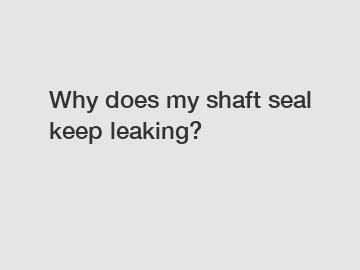Why does my shaft seal keep leaking?
Why does my shaft seal keep leaking? .
Shaft seal leaks can be frustrating and costly. These leaks can lead to equipment downtime, loss of productivity, and even damage to the machinery. Understanding the reasons behind these leaks can help to prevent them from reoccurring. In this article, we will explore some common causes of shaft seal leaks and discuss possible solutions to this persistent problem.
1. Faulty Installation:

One of the primary reasons why shaft seals may keep leaking is due to improper installation. If the seal is not installed correctly, it may not be able to create an effective barrier between the rotating shaft and the surrounding environment. This can result in leaks. Ensure that the seal is installed according to the manufacturer's guidelines, using the correct tools and techniques.
2. Seal Wear and Tear:
Over time, shaft seals may deteriorate, leading to leaks. The constant friction and exposure to harsh conditions can cause the seal to lose its effectiveness. Additionally, abrasive or corrosive substances in the fluid being sealed can accelerate wear and tear. Regular maintenance and inspection can help identify signs of seal degradation early on, allowing for timely replacement.
3. High Shaft Speed:
Shaft speed plays a crucial role in the performance of a shaft seal. Excessive speeds can generate higher pressures and temperatures, increasing the likelihood of leaks. If the seal is not designed to withstand these conditions, it may fail to maintain a tight seal. Consider using seals specifically designed for high-speed applications or adjusting the operating conditions to reduce the speed.
4. Inadequate Lubrication:
Proper lubrication is essential for the smooth operation of a shaft seal. Insufficient lubrication can cause the seal to overheat, leading to leaks. Additionally, improper lubrication can result in increased friction, hastening seal wear and tear. Follow the manufacturer's recommendations for lubrication intervals and use the correct lubricant to ensure optimal performance.
5. Seal Material Compatibility:
Using the wrong seal material can lead to frequent leaks. Different fluids require seals made from specific materials that are compatible with their chemical composition. Using an incompatible seal material can cause swelling, degradation, or even rapid failure. Ensure that the seal material is suitable for the fluid being sealed, especially in cases where the fluid may contain aggressive or corrosive chemicals.
6. Pressure Variations:
Seal leaks can also be caused by pressure variations within the system. When the pressure exceeds the seal's design limits, it can force fluid past the seal, resulting in leaks. Installing pressure relief valves or regulating the system pressure can help prevent excessive pressure build-up and minimize the risk of leaks.
7. Improper Shaft Alignment:
Misalignment of the shaft can put unnecessary stress on the seal, leading to leaks. A misaligned shaft can create additional friction and uneven contact between the seal and the shaft, compromising its sealing capability. Regularly monitor and adjust shaft alignment to maintain optimal conditions for the seal.
In conclusion, there are several potential reasons why a shaft seal may keep leaking. From faulty installation to wear and tear, high shaft speeds to inadequate lubrication, material compatibility issues to pressure variations, and improper shaft alignment – each factor can contribute to seal leaks. By identifying the root cause of the problem and addressing it with appropriate solutions, such as proper installation, regular maintenance, using suitable material, and optimizing operating conditions, it is possible to mitigate the frequency of leakages and ensure the longevity of the shaft seal. Take the necessary steps to prevent and resolve seal leaks, as it will save you time, money, and unnecessary frustration in the long run.
For more information, please visit a seal used between stationary components, high pressure seals industry, seamless pipe indonesia.
227
0
0

Comments
All Comments (0)